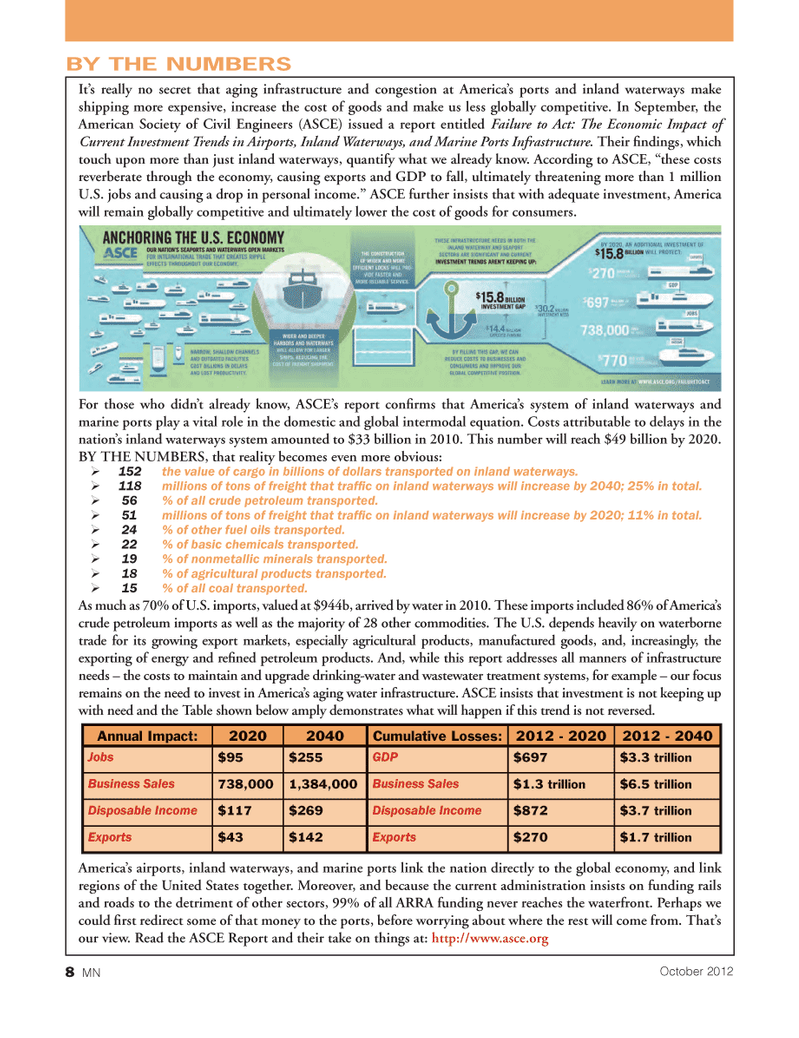
Page 8: of Marine News Magazine (October 2012)
Year in Review & Leadership
Read this page in Pdf, Flash or Html5 edition of October 2012 Marine News Magazine
It?s really no secret that aging infrastructure and congestion at America?s ports and inland waterways make shipping more expensive, increase the cost of goods and make us less globally competitive. In September, the American Society of Civil Engineers (ASCE) issued a report entitled Failure to Act: The Economic Impact of Current Investment Trends in Airports, Inland Waterways, and Marine Ports Infrastructure . Their ndings, which touch upon more than just inland waterways, quantify what we already know. According to ASCE, ?these costs reverberate through the economy, causing exports and GDP to fall, ultimately threatening more than 1 million U.S. jobs and causing a drop in personal income.? ASCE further insists that with adequate investment, America will remain globally competitive and ultimately lower the cost of goods for consumers. For those who didn?t already know, ASCE?s report con rms that America?s system of inland waterways and marine ports play a vital role in the domestic and global intermodal equation. Costs attributable to delays in the nation?s inland waterways system amounted to $33 billion in 2010. This number will reach $49 billion by 2020. BY THE NUMBERS, that reality becomes even more obvious: �¾ 152 the value of cargo in billions of dollars transported on inland waterways. �¾ 118 millions of tons of freight that traf Þ c on inland waterways will increase by 2040; 25% in total. �¾ 56 % of all crude petroleum transported. �¾ 51 millions of tons of freight that traf Þ c on inland waterways will increase by 2020; 11% in total. �¾ 24 % of other fuel oils transported. �¾ 22 % of basic chemicals transported. �¾ 19 % of nonmetallic minerals transported. �¾ 18 % of agricultural products transported. �¾ 15 % of all coal transported. As much as 70% of U.S. imports, valued at $944b, arrived by water in 2010. These imports included 86% of America?s crude petroleum imports as well as the majority of 28 other commodities. The U.S. depends heavily on waterborne trade for its growing export markets, especially agricultural products, manufactured goods, and, increasingly, the exporting of energy and re ned petroleum products. And, while this report addresses all manners of infrastructure needs ? the costs to maintain and upgrade drinking-water and wastewater treatment systems, for example ? our focus remains on the need to invest in America?s aging water infrastructure. ASCE insists that investment is not keeping up with need and the Table shown below amply demonstrates what will happen if this trend is not reversed. America?s airports, inland waterways, and marine ports link the nation directly to the global economy, and link regions of the United States together. Moreover, and because the current administration insists on funding rails and roads to the detriment of other sectors, 99% of all ARRA funding never reaches the waterfront. Perhaps we could rst redirect some of that money to the ports, before worrying about where the rest will come from. That?s our view. Read the ASCE Report and their take on things at: http://www.asce.org BY THE NUMBERSAnnual Impact:20202040Cumulative Losses:2012 - 20202012 - 2040 Jobs$95$255 GDP$697$3.3 trillionBusiness Sales738,0001,384,000 Business Sales$1.3 trillion$6.5 trillion Disposable Income$117$269 Disposable Income$872$3.7 trillionExports $43$142 Exports $270$1.7 trillion8 MNOctober 2012MNOct2012 Layout 1-17.indd 8MNOct2012 Layout 1-17.indd 810/2/2012 9:30:39 AM10/2/2012 9:30:39 AM

 7
7

 9
9
